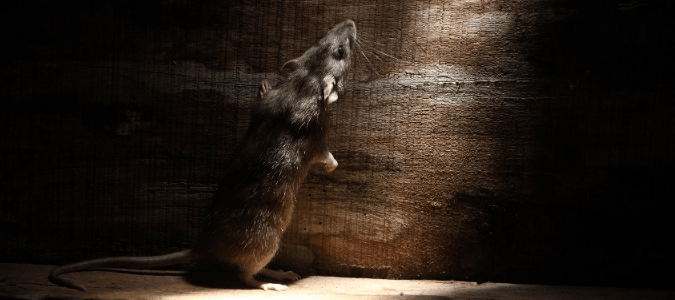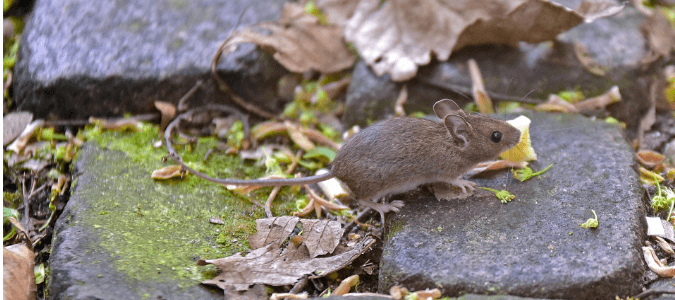Do Dogs Keep Mice Away?

There is one way dogs can be helpful with pest control, and that is with identifying the problem in the first place. With its highly sensitive hearing, your dog might be able to identify a pest problem that you weren’t aware of. When dogs hear squeaking and scratching sounds coming from inside the ceiling or walls, they often stare fixedly, bark or whine at the spot where the sounds are originating. This can let you know there’s something going on that needs to be investigated.
The signs of a mouse infestation can often go unnoticed for quite some time before the people living in the home realize they have a pest problem. This is partly because mice are nocturnal animals, which means they are mostly active at night. They hide and rest during the day, and venture out to forage for food only under the cover of darkness. This is a big reason why many people have no idea there are mice living in the home until the problem has grown into a full-blown infestation.
Of course, there are signs you can look out for to know whether there are mice nearby. If you see mouse droppings—small, dark-brown, elongated pellets—or gnaw marks on your baseboards, door frames or other areas of your home, these can signal the presence of mice. Another common sign is loose, shredded cloth, insulation or paper that could be from a mouse nest. You might also see greasy tracks along the baseboards or higher up, such as along the wall next to a rafter or beam that mice habitually walk along. Occasionally, people will spot actual mice, either living or dead.
When you have a mouse problem, it’s important to deal with it as quickly and effectively as possible, because these small animals can cause big problems. Since mice are rodents, they must gnaw every day to keep their constantly growing front teeth from getting too long. Mice are known for chewing their way through wood framing, drywall, PVC piping and even electrical wiring in people’s homes, attics and garages. This can be very costly to fix, and it can even create serious structural or fire hazards.
Even mouse urine and feces can cause property damage. When mice build a nest and breed, their populations can quickly explode, which means a lot of mice living and eliminating in one place. Their urine can seep through the wall or ceiling, or wherever they’ve built their nest. Mouse feces and urine are dangerous for people to come into contact with. These rodents carry bacteria and germs that can cause serious illnesses in humans, and their waste products are contaminated with the same germs and diseases.
Unfortunately, mice are notoriously difficult to control, especially for people trying to do it themselves without the help of a pest control professional. This is primarily because mice are so adept at staying hidden, plus they are incredibly prolific breeders. Female mice don’t have a particular breeding season, which means they can—and do—breed throughout the year. One female mouse can have five to ten litters a year, with six to eight babies per litter. That means a single mouse can have sixty babies or more in just one year—and often there are multiple females breeding at once. With these quickly expanding numbers, it’s easy to see why a nest of mice can quickly grow out of control.
You can do several things to keep mice away from your home—namely, making your home less attractive to them in the first place. Some things to try include:
- Keep all food, including pet food, properly stored in airtight containers with tightly fitting lids.
- Keep your home and especially your kitchen clean, wiping up spills and sweeping away crumbs on a regular basis.
- Fix any leaking faucets or pipes, so mice don’t have a ready source of water.
- Cut off pests’ access to your home by closing off any gaps or holes they may be using to get inside. You can repair gaps, cover them with wire mesh or stuff them with steel wool. Remember that gaps may be around vents in exterior walls, around doors and windows, in the eaves, or in the form of rips in window or door screens.
If you have a mouse problem, it can be a frustrating and ultimately exhausting endeavor to try to get rid of them on your own. Often, the quickest, most effective way to deal with it is to contact a wildlife control specialist to get rid of the pests and prevent their return in the future. Pest control professionals have the necessary know-how and experience as well as access to the latest tools and techniques to deal with the problem in a comprehensive way.
When dealing with a mouse problem, many homeowners become concerned with where these pests may be around the home. Keep reading to learn whether mice can climb stairs and what may have attracted these creatures to your home in the first place.

Can Mice Climb Stairs?
Mice might as well be tiny gymnasts; that’s what naturally amazing climbers and jumpers they are. So, yes, mice can climb stairs. They can even climb up a vertical wall if its surface is rough enough for the mouse to scale with its tiny claws.
Mice are small enough that they often don’t weigh more than a few ounces, even when fully grown. They have small, sharp claws and a tail that helps them with balance. These adaptations make it easy for them to climb on many different types and textures of surfaces, including tree trunks outdoors, wooden boards (such as a wooden fence or the framing inside the walls of your home), painted drywall and more. Glass is one of the only surfaces that is smooth enough that mice can’t climb on it, if it’s fully vertical—although they can likely climb up a glass surface if it’s at an angle.
This means mice can access areas and spaces that are high up in your home, including the second floor, the eaves or the attic. This can be an alarming discovery for most homeowners, particularly ones who are terrified of mice. Thankfully, there are things you can do to keep mice out of your bed and away from your living areas.
If you see mouse droppings someplace inside your home or garage, that means mice (or perhaps rats) have been there. Greasy track marks along a wall or baseboard mean the same thing. Mice tend to habitually follow the same paths again and again, and they prefer to stick close to walls rather than walking out in the open. The natural oils present on their fur rub off on the walls, creating greasy marks that signal their presence to anyone observant enough to spot the tracks. If you see these or other signs that mice are living in or around your home, it’s time to reach out to a pest control specialist who can deal with the problem.

What Are Mice Attracted To?
When mice get into your home and build a nest for breeding, it means they’ve found everything they need to live a good life inside. If you want to create a pest-free space that won’t draw mice, you need to look around your house and consider what might have drawn these creatures into your home. Fortunately, the answer is simple: Mice are attracted to the same things every animal needs—namely, food, water and shelter.
When mice get inside your house, the first thing that should tell you is that they were able to get in. This indicates there are access points that will have to be closed off to ensure mice and other pests can’t get inside again in the future. Mice can squeeze through holes smaller than a dime, so look around your doors, windows and exterior walls for any holes or gaps that might provide pests access to your interior walls. Look for gaps around vents and exterior faucets, as well as for cracks or holes in the foundation, in the eaves or near door or window frames. Rips in screens on doors and windows are also potential access points that should be repaired.
Inside, mice are seeking food and water, so to make your home mouse-proof, you’ll have to make sure they don’t have access to these basic necessities. Don’t leave standing water in house plants, and fix any leaky faucets or pipes. Try not to leave food out, including pet and bird food, and keep all food stored in airtight containers that mice can’t gnaw their way into. Keep your home clean, especially your kitchen. It’s important to wipe up any crumbs or food spills that would attract pests of all types, including German and American cockroaches.
These measures can go a long way toward keeping mice out of your home, but if they do get inside, and especially if they build a nest and breed, you’ll need to reach out to a pest control specialist who knows how to control a rodent infestation and keep these pests away for good.
Chem-free Can Remove Unwanted Creatures
Few home remedies are effective when it comes to rodents, making these infestations extremely difficult for homeowners to handle on their own. Instead of struggling for an extended period of time without results, contact Chem-free for effective rodent control. We will create an effective treatment plan for pest control with your kids’ safety in mind, and also one that considers any furry family members you might have.
Need Help Managing Pests?
Chem-Free offers both effective, low-impact pest control options and preventative measures to help avoid future infestations. Contact us today for a free estimate!


